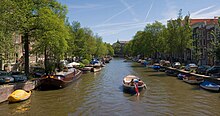Prinsengracht
The Prinsengracht (German "Prinzengraben") is the outermost, furthest from the Amsterdam old town and with 3.2 kilometers longest main canal of the Amsterdam canal belt . It is located in the Amsterdam city center .
history
The construction of the Prinsengracht, like the two other main canals, the Herengracht and Keizersgracht , began in 1612 on the initiative of the Amsterdam mayor Frans Hendricksz Oetgens van Waveren according to plans by city architect Hendrick Jacobsz Staets and city surveyor Lucas Jansz Sinck. It was named in honor of the Princes of Orange .
The section between Leidsegracht and Amstel was only laid out in 1658. The extension on the other side of the Amstel is called Nieuwe Prinsengracht ("New Prinzengraben"). At the other end of the Prinsengracht, it is extended between Brouwersgracht and Westerdok by the Korte Prinsengracht ("Kurzer Prinzengracht").
Every year in August, the Amsterdam Gay Pride , a canal parade, runs through the Prinsengracht, among other places.
Buildings

On the left, formerly Opekta , on the right, Keg's Koffiehandel , today the Anne Frank House
On the Prinsengracht there are a number of noteworthy buildings and other architectural details such as:
- On Prinsengracht 2–3: a stepped gable at the corner of Brouwersgracht
- On Prinsengracht 89–133: Van Brienenhofje , an empire- style Hofje from 1804
- On Prinsengracht 126: a ledge gable
- On Prinsengracht 299: Casteel van Beveren , Baroque style house from 1720; since a renovation in 1996/97 a residential building with 24 apartments
- At 263 Prinsengracht: the Opekta building from 1635 with a rear building from 1740 (the third address of the Dutch Opekta from 1940 to 1955); the hiding place of - among other things - Anne Frank
- On Prinsengracht 263–267: since 1960 Anne Frank House
- On Prinsengracht 281 (on Westermarkt ): the Westerkerk with its striking west tower
- At Prinsengracht 300: De Roode Vos ("The Red Fox") with a bell gable
- On Prinsengracht 436: the Palace of Justice, built in 1829
- On the Prinsengracht 556: a typical example of a funnel gable from the 19th century
- On Prinsengracht 754–756: De Duif church from 1858
- On Prinsengracht 769: the Prinsengracht Hospital
- On Prinsengracht 849: a neck gable from 1701
- On Prinsengracht 855–899: Deutzenhofje from the 17th century
Between Prinsengracht 16 and 18 - on the Westerstraat - is the Noordermarkt with the Noorderkerk built around 1623 . Between Prinsengracht 1047 and 1049 - on the Utrechtsestraat - lies the Amstelveld with the Amstelkerk built in 1670 as a makeshift church .
History and numbering
The Prinsengracht begins in the north on the Brouwersgracht and runs parallel to the Keizersgracht to the southeast, where it flows into the Amstel . The odd numbers are on the bank side facing the old town.
See also
- Canals in Amsterdam
- Nine streets , side streets of the "Amsterdam Canal Belt"
- Houseboat Museum , Prinsengracht 296 K
- Pipe Museum Amsterdam , Tobacco Pipe Museum , Prinsengracht 488
- Amsterdam Tulip Museum ( Tulip Museum ), Prinsengracht 116
Individual evidence
Detailed description of the monuments by Monuments & Archeology (BMA) in Dutch (illustrated):
- ↑ Prinsengracht 2-4 (1641) ( Memento from September 27, 2006 in the Internet Archive )
- ↑ Prinsengracht 126 (± 1755) ( Memento from September 27, 2006 in the Internet Archive )
- ↑ Prinsengracht 299, 't Casteel van Beveren (± 1720) ( Memento from March 27, 2007 in the Internet Archive )
- ↑ Paleis van Justitie, vm. Aalmoezeniersweeshuis (1663/65, 1825/29) ( Memento from April 17, 2008 in the Internet Archive )
- ^ RK kerk Sint Willibrordus binnen de Veste, 'De Duif' (1857) ( Memento from September 27, 2006 in the Internet Archive )
- ↑ Prinsengracht 849 (1701) ( Memento from September 27, 2006 in the Internet Archive )
- ↑ Deutzenhofje (1695) ( Memento from June 7, 2007 in the Internet Archive )
Web links
Coordinates: 52 ° 21 '58 " N , 4 ° 52' 58" E


